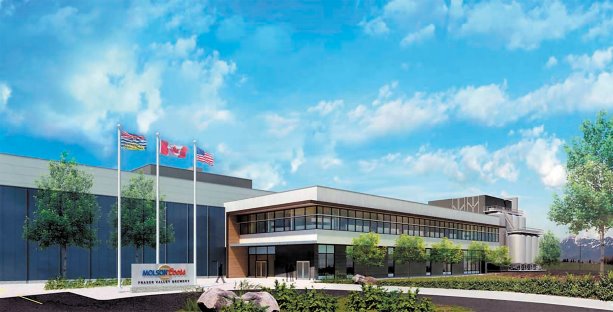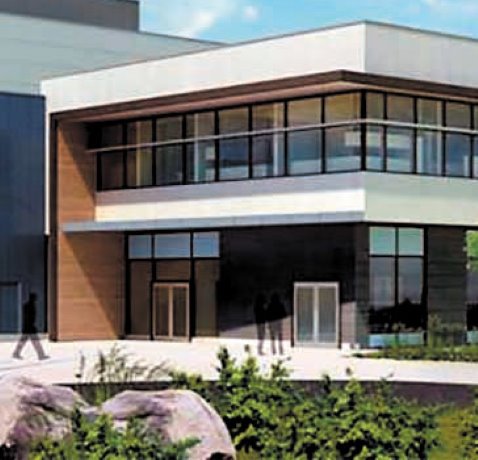The City of Chilliwack is building a wastewater pre-treatment plant to handle discharge from the new Molson Coors brewery, a $200 million plus facility, under construction in the Fraser Valley city.
"As part of the project and because the brewer will have high-strength wastewater, a pre-treatment plant was needed," said David Blain, the city’s director of engineering and planning.
Liquid wastewater is classified into low, medium, or high strength according to the amount of organic material or biochemical oxygen demand (BOD) found in the liquid. Municipal wastewater is rated as low strength.
Blain said the process of pre-treating water from breweries is common throughout B.C. as brewers attempt to reduce the amount of organic material in discharged wastewater before it flows into the municipal treatment system. The same process is common in food processing or slaughterhouses, which often have their own pre-treatment facilities before discharging water into public systems.
The system being installed in Chilliwack is an up-flow anaerobic sludge blanket type reactor. It essentially feeds the wastewater and organic material into the bottom of a large steel tank, where water goes through a granular biomass zone or blanket of material with clarified water rising to the top of the tank.
The tank also captures the emitted gases that occur during the breakdown of material in the biomass zone. When the wastewater emerges from the clarifier zone, it is directed into the city’s system; gases can also be collected.
Blain said the city is currently looking at collecting the biogas generated from the system to use for power generation.
The pre-treatment plant is a partnership with Molson Coors and the brewer contributing to the capital cost while the city will own and operate the plant.
Molson Coors’s iconic brewery plant by Vancouver’s Burrard Street Bridge had been a landmark for the past 50 years. But, in 2016 it was sold for $185 million to Hong Kong developer Concord Pacific and the brewer purchased a 36-acres site, located along Kerr Avenue in Chilliwack’s food park. The site provides easy access to both U.S. and Canadian markets.
Breweries are large consumers of water with older plants using 10 litres of water (for washing glass bottles or the brewing process) compared to one litre of beer produced. More efficient plants operate with only four litres of water to one litre of beer produced.
Josh Stewart, corporate affairs in Western Canada, said bottle washing will be done off site.
"Molson Coors is proud of the fact that the new brewery will achieve LEED certification and strive for maximum efficiency on utility use and waste management."
Vancouver general contractor Smith Brothers and Wilson started construction on the new brewery in April with 1,000 jobs created during 18-month construction period. PCL Constructors Westcoast Inc. has been chosen as the general contractor for the pre-treatment plant, which needs to be in place before the brewery start-up.
Associated Engineering has the engineering design contract of the pre-treatment plant. Project engineer Tom Robinson said high-strength wastewater from the brewery will go into a 4.5 kilometre dedicated force main that will carry it to the new anaerobic pre-treatment facility located next to the city’s wastewater secondary treatment plant on Wolfe Road.
Chilliwack’s wastewater treatment plant (which consists of both primary and secondary treatment) processes up to 45,000 cubic metres per day with solid materials removed and trucked away by a private company. Fluid is treated through a biological process and purified prior to the treated effluent being discharged to the Fraser River. The additional input of wastewater is not expected to significantly increase the amount of water discharged into the river.
Pre-treatment of the Molson Coors material lessens the impact on the city’s treatment facility.
"It greatly reduces the energy required for aeration for the biological treatment process and avoids the need for a significant expansion (of Chilliwack’s current) facility," Thompson said.
Global Water & Energy (GW&E) was chosen by Chilliwack council as the preferred proponent to supply the anaerobic wastewater reactor system. GW&E is working with H2Flow Equipment Inc. located in Vaughan, Ont., to supply the equipment.
Anaerobic digesters are used to break down more solid materials while reactors are used for wastewater liquids and it is the anaerobic process which produces the bio-gas.
H2Flow president Michael Albanese said that when the strength of the wastewater is high, an anaerobic reactor system is the best choice as it requires less energy and the facility itself results in a smaller foot print on site.
Blain said the city looked at a number of technology suppliers and chose GW&E because of its global experience in supply systems and numerous applications of this type.
The reactor is expected to be on line by late 2018 with the Molson Coors state-of-the-art plant starting up in early 2019.

A new Molson Coors brewery will require pre-treatment of its wastewater before it is combined with the secondary treatment plant operated by the City of Chilliwack. The wastewater facility, featuring an anaerobic reactor, will be constructed by PCL Constructors Westcoast.
Photo: Molson Coors of Canada"










Recent Comments
comments for this post are closed